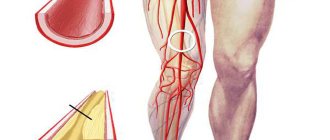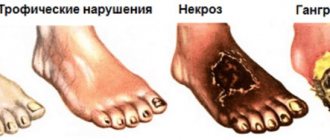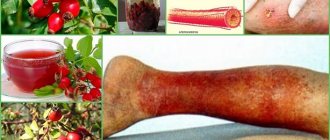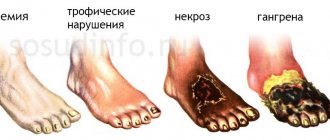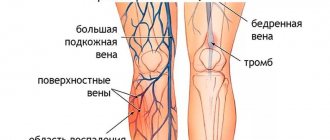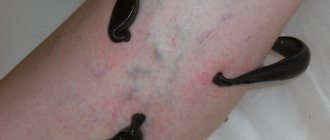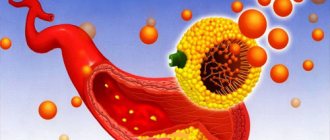What it is
In order to understand what obliterating atherosclerosis of the vessels of the lower extremities is, you need to have a general understanding of atherosclerosis. This disease occurs due to elevated cholesterol levels in the blood.
Total cholesterol is divided into fractions. One of them, high-density lipoprotein (HDL), is considered healthy cholesterol. The rest are very low density lipoproteins (VLDL), low density lipoproteins (LDL) and triglycerides - atherogenic, bad cholesterol.
When the values of atherogenic fractions are greatly increased, atherosclerotic plaque begins to be deposited on the intima (inner surface) of the vessel, which, over time, forms plaques. The disease lasts for years without showing any noticeable symptoms.
In later stages, atherosclerotic plaques undergo a process of calcification and transform into blood clots.
If plaques, having at first a loose structure, still leave the lumen of the vessel, although they significantly narrow it, then blood clots are more dense in structure, and most often block the vessel completely. Both plaques and blood clots tend to break off, either partially or completely.
And then, depending on which part of the body the plaque or blood clot gets stuck in, a stroke or heart attack will occur. If this process occurs in the vessels of the brain, it is a stroke; in other parts of the body, it is a heart attack.
The name obliterating atherosclerosis of the lower extremities comes from the word obliteration, which means fusion or closure of a tubular or cavitary organ. The disease affects the blood vessels of the legs.
When atherosclerotic deposits completely block the vessel, the supply of oxygen and nutrients to the adjacent tissues is stopped. Necrosis begins - cell death.
If appropriate measures are not taken in time, gangrene begins, and then there is only one way out to prevent sepsis and death - amputation.
Treatment of atherosclerosis of the heart vessels
The choice of treatment method depends almost entirely on the stage of development of atherosclerosis. If the disease is detected in a timely manner, it is sufficient to use medications that help lower cholesterol levels in the body.
The most important element of treatment is a change in lifestyle, the patient’s desire to reduce the number of stressful situations and reduce physical stress on the body to moderate levels. An important factor influencing the process of getting rid of the disease in the body is changing the diet and following a diet aimed at reducing cholesterol concentrations.
If drug treatment does not lead to stabilization of the condition, then a decision is made to carry out a procedure to widen the area of the vessel affected by atherosclerosis by implanting a stent. In addition to this procedure, a bypass technique can be used, which involves creating an additional path in the blood supply, which allows you to bypass the area of the vascular system affected by the disease.
Causes
The main factors that trigger the development of the disease come from the actions of the patients themselves. This is unhealthy diet and bad habits.
In general, all causes can be divided into three groups:
- Unremovable. These are criteria that do not depend on the patient’s behavior and which cannot be influenced. These include:
- Age - since over the years, absolutely all people’s blood vessels wear out and undergo atherosclerotic processes;
- Genetics – this disease can be inherited between close relatives.
- Partially removable. This subgroup includes those reasons that caused atherosclerosis or that aggravate its course. These are related diseases:
- Diabetes;
- Hyperlipidemia;
- Obesity;
- Hypertension, etc.
- Removable. These are the most common causes of the disease. This:
- Smoking is the most common cause of atherosclerosis, because tobacco tar and nicotine settle on the inside of the vessels, injuring and making them brittle, polluting and clogging the vascular lumens;
- Alcohol – due to frequent consumption of alcohol, improper redistribution of blood pressure occurs, and its surges are a favorable environment for the formation and separation of blood clots;
- Poor nutrition – food rich in animal fats provokes the accumulation of low-density lipoproteins, which then form plaques in the blood vessels;
- Physical inactivity is a sedentary lifestyle in which all metabolic processes in the body are disrupted and which leads to an increase in LDL in the blood.
All of the above reasons trigger the development of atherosclerosis; if it is possible to eliminate them at an early stage of the disease, this will be the key to successful treatment.
Short description
Atherosclerosis of the coronary arteries with their hemodynamically significant stenosis leads to the emergence of various clinical variants of coronary heart disease (see Coronary heart disease) • In addition to atherosclerosis (more than 90% of cases of coronary artery disease), coronary artery disease can be caused by arteritis, collagenosis, thrombosis and embolism, anomalies in the development of coronary vessels and etc.
Code according to the international classification of diseases ICD-10:
- I25.1 Atherosclerotic heart disease
Frequency - see Coronary heart disease.
Development mechanism
First, the patient's level of low-density lipoproteins in the blood increases. This is the beginning of the disease. Therefore, it is important not to miss this moment, and you can find out about this only by taking tests during a preventive examination. This is why it is useful to visit the clinic regularly, especially for patients at risk.
Over time, low-density lipoproteins accumulate and begin to be deposited on the inner surface of blood vessels. High-density lipoproteins prevent this, performing a directly proportional function and cleaning the blood vessels. This is why HDL is called good cholesterol.
But if no therapeutic action is taken at this stage, then constant excess LDL will begin to form atherosclerotic plaques.
The ideal environment for the creation of plaques are microtraumas and microcracks of blood vessels; it is in these places that atherosclerotic plaque begins to settle and grow.
With age, all people's blood vessels lose elasticity and become brittle. Therefore, patients over forty years of age are already at risk. This is especially true for men, since women of reproductive age are protected from this pathology by a natural sex hormone.
In the postmenopausal period, the risk of developing atherosclerosis in women becomes the same as in men.
Obliterating atherosclerosis of the vessels of the lower extremities: symptoms, classification, ICD-10 code
Atherosclerotic disease complicated by occlusion can cause thromboembolism, trophic ulcers and gangrene. Diagnosing any of these problems requires knowledge of the ICD 10 condition coding.
Atherosclerosis of the lower extremities in the International Classification of Diseases, 10th revision, is in sections I70 - I79. Usually, the code of a specific disease is well known to doctors specializing in the treatment of vascular pathology.
However, doctors of all specialties may encounter problems with the circulatory system presented in ICD 10, so you should have information on specific conditions that arise against the background of vascular diseases.
Blockage of arterial trunks anywhere in the body can manifest itself in a variety of symptoms. Knowing the diagnosis code will help you quickly navigate a large number of vascular diseases.
Proper diet
- seafood – the eicosanoic acid they contain neutralizes cholesterol accumulated in the blood;
- poultry meat – chicken breast, turkey;
- vegetable salads seasoned with vegetable oil (linseed, olive, refined sunflower);
- fiber – to remove excess fats, cholesterol and toxins from the body;
- legumes;
- low-fat fermented milk products - cottage cheese, kefir, yogurt, yogurt;
- herbal teas;
- juices made from fresh fruits and vegetables.
In case of cerebral atherosclerosis, it is necessary to exclude from the menu foods rich in cholesterol and harmful to health. These include:
- pork, beef and fatty fish;
- broths and soups with broth;
- offal products – liver, kidneys, animal brains;
- chocolate, creams containing cocoa;
- sweet baked goods – cakes, pastries, buns and pies;
- pickled, spicy and smoked dishes;
- animal fat, lard;
- eggs;
- alcohol;
- strong coffee, black tea.
Patients with atherosclerosis are recommended to eat steamed food, and the amount of salt in it should be limited.
The volume of fluid consumed per day to ensure optimal metabolism in the body should be at least 1.5 liters.
More detailed instructions and recommendations on dietary nutrition should be provided by the doctor, based on the characteristics of the diagnosis and the individual needs of the body.
https://youtu.be/hPD1ku6AzgE
Group of diseases associated with atherosclerotic lesions
All diseases that occur against the background of uncomplicated or complicated atherosclerosis are systematized under the code I70 and include the following pathology options:
- atherosclerotic disease of the aorta (I70.0);
- damage to the renal arteries (I70.1);
- atherosclerosis of the arteries of the lower extremities (I70.2);
- narrowing of any other arteries caused by pathological atherogenesis (I70.8);
- multiple or unspecified pathological process occurring against the background of atherosclerosis (I70.9).
The doctor can use any code from ICD 10 to indicate a diagnosis of vascular pathology. It is necessary to divide atherosclerosis of the lower extremities into 2 parts - complicated or uncomplicated. Obliterating vascular atherosclerosis is coded I70.2.
Short description
Recommended by the Expert Council of the Republican State Enterprise at the Republican Center for Healthcare Development of the Ministry of Health and Social Development of the Republic of Kazakhstan dated November 30, 2020 Protocol No. 18 Atherosclerosis of the abdominal aorta and arteries of the lower extremities is an occlusive lesion of the bifurcation of the aorta, iliac arteries and arteries of the lower extremities, characterized by a symptom complex of chronic ischemia of the lower extremities and pelvic organs [1].
Protocol name: Atherosclerosis of the abdominal aorta and arteries of the lower extremities. ICD-10 code(s): I70.0 Atherosclerosis of the aorta I70.2 Atherosclerosis of the arteries of the extremities I70.8 Atherosclerosis of other arteries I74.0 Embolism and thrombosis of the abdominal aorta I74.3 Embolism and thrombosis of the arteries of the lower extremities Abbreviations used in the protocol:
| BP–blood pressure APTT–activated partial thromboplastin time HIV–human immunodeficiency virus STBA–posterior tibial artery IHD–coronary artery disease ELISA–enzyme-linked immunosorbent assay CT–computed tomography CTA–computed tomographic angiography HDL–high-density lipoproteins LDL–low-density lipoproteins ABI –ankle-brachial index INR–international normalized ratio MRA–magnetic resonance angiography MRI–magnetic resonance imaging MSCT–multispiral computed tomography angiography stroke–acute cerebrovascular accident OBA–common femoral artery RCA–popliteal artery SFA–superficial femoral artery SBFA – anterior tibial artery TGD – triglycerides USDG – Doppler ultrasound ultrasound – ultrasound examination UD – level of evidence ECG – electrocardiogram |
Protocol development date: 2020. Patient category: adults. Users of the protocol: general practitioners, angiosurgeons.
Note: The following classes of recommendations and levels of evidence are used in this protocol: Classes of recommendations: Class I – the benefit and effectiveness of a diagnostic method or treatment intervention has been proven and/or generally accepted Class II – conflicting data and/or divergent opinions regarding the benefit/efficacy of treatment Class IIa – available evidence suggests that treatment is beneficial/effective Class IIb – benefit/effectiveness is less convincing Class III – available evidence or consensus suggests that treatment is not beneficial/effective and may in some cases be harmful
| A | A high-quality meta-analysis, systematic review of RCTs, or large RCTs with a very low likelihood of bias, the results of which can be generalized to an appropriate population. |
| IN | High-quality ( ) systematic review of cohort or case-control studies or High-quality ( ) cohort or case-control studies with very low risk of bias or RCTs with low ( ) risk of bias, the results of which can be generalized to an appropriate population. |
| WITH | Cohort or case-control study or controlled trial without randomization with low risk of bias ( ). The results of which can be generalized to the relevant population or RCTs with very low or low risk of bias ( or ) whose results cannot be directly generalized to the relevant population. |
| D | Case series or uncontrolled study or expert opinion. |
| GPP | Best pharmaceutical practice. |
Vascular complications of the legs, systematized in the International Classification
Pathology of the aorta or large main arteries is of great importance for ensuring blood flow in the legs.
In particular, if an atherosclerotic plaque has led to disruption of blood flow, then an expansion similar to a saccular aneurysm will form above the narrowing.
If atherosclerosis provokes the formation of aneurysmal expansion in the area of the aorta or underlying vessels, then the doctor will set the following code from the 10th revision classification:
- aneurysm of the abdominal aorta with or without rupture (I71.3-I71.4);
- dilatation of the iliac arteries (I72.3);
- aneurysm of the arteries of the lower extremities (I72.4);
- aneurysmal dilatation of specified or unspecified localization (I72.8 -I72.9).
In the group of peripheral vascular pathology, the International Classification of the 10th revision identifies the following pathology options:
- vascular spasm of small arteries or Raynaud's syndrome (I73.0);
- thromboangiitis obliterans, combining inflammation and thrombosis (I73.1);
- specified or unspecified peripheral vascular diseases (I73.8-I73.9).
If atherosclerosis in the area of the vessels of the legs causes thrombotic complications, then these types of problems are grouped in the following codes:
- thromboembolism of the abdominal aorta (I74.0);
- thrombosis of the arteries of the lower extremities (I74.3);
- obstruction of the iliac arteries by thrombi or emboli (I74.5).
The obliterating variant of vascular pathology is coded as standard. If severe complications occur (gangrene, trophic ulcers), the ICD 10 code corresponds to the usual code, as does atherosclerosis of the arterial trunks of the femur and leg (I70.2).
Every doctor needs to know and use the International Classification of Diseases codes. In the case of pathology of the blood vessels of the legs, it is important to understand that under one code there can be different options - obliterating or uncomplicated atherosclerosis of the lower extremities.
Depending on the preliminary diagnosis, the doctor will use optimal and informative diagnostic methods to confirm the disease variant and choose the best type of therapy. The presence of complications is of great importance: if the doctor sees gangrenous foci, then treatment must be started immediately.
However, in all cases, prevention will give the best effect, so you should follow the doctor’s recommendations at the stage of minimal atherosclerotic symptoms, without waiting for skin ulceration or gangrenous lesions of the legs to appear.
Read also: Atherosclerosis of the cerebral arteries
Stages
Obliterating atherosclerosis of the vessels of the lower extremities has four main stages:
- At the first stage, stenosis is just beginning to appear. The patient may feel some tingling in the legs, most often patients describe this condition as a “pins and needles” feeling. The skin on the legs is much paler than in other parts of the body.
- The second stage has two subtypes:
- A - at this stage of development, the patient develops intermittent claudication, he can walk about 200 meters and begins to feel pain, which goes away after rest;
- B – at this stage, the feeling of stiffness and pain in the legs does not allow the patient to walk even 200 meters.
- At the third stage of the disease, the pain becomes more intense and begins to bother the patient even at rest.
- The fourth stage is the final one. During this period, the patient’s legs become covered with trophic ulcers, tissue necrosis begins and, in the absence of the necessary therapy, gangrene develops.
- The final stage usually ends with the loss of part of the leg because there is a risk of death.
There is also a gradation of stages regarding the prevalence of obliterating atherosclerosis:
- Segmental obliteration is a type of atherosclerotic lesion of only one part of the leg.
- Widespread occlusion - damage to the entire block of the femoral artery.
- Impaired patency of the popliteal and femoral arteries.
- Complete closure of the femoral and popliteal arteries while maintaining the blood supply to the deep femoral arteries.
- The final stage, which is characterized by tissue necrosis and subsequent gangrene.
If gangrene develops, the patient needs urgent surgery, without which there is a risk of death.
Causes
The etiology in most cases is unknown • The main role, apparently, belongs to various disorders of lipid metabolism (see Hyperlipidemia), detected in almost all patients with coronary artery disease • In some cases, atheromatosis is accompanied by diffuse distal sclerosis of the coronary arteries without local lipid infiltration of their wall (X - syndrome).
Pathophysiology • The heart requires 0.1–0.2 ml of oxygen per 1 g of weight per minute. Such intense gas exchange is possible due to the high perfusion pressure in the coronary arteries arising directly from the aortic ostium, the high inflow volume of 5% of the bcc, and the increased extraction of oxygen by the myocardium (more than 75% at rest and almost 100% at maximum load) • With stenosis of the coronary arteries of less than 70–75% of their lumen, disturbances in myocardial perfusion occur only during exercise, and at rest the decrease in perfusion does not exceed 5% of normal values • Even with complete occlusion of one of the main coronary arteries, the level of perfusion of the “compromised” myocardial zone is reduced by only 50 % due to collateral circulation • With hemodynamically significant stenoses of several coronary arteries, the dependence of impaired myocardial perfusion at rest on the degree of stenosis is almost linear, therefore multi-vessel damage is always associated with a worse prognosis • As a rule, even in the area of the previous infarction, a certain amount of viable myocardium remains (see . Heart disease is ischemic), therefore revascularization interventions improve the contractile function of the heart even in the area of infarction • When assessing the degree of damage to the coronary bed by atherosclerosis and choosing tactics, the following classification is used.
Classification of atherosclerosis of the coronary arteries (Petrosyan-Zingerman) • Anatomical type of blood supply to the heart •• Predominantly left (about 10%) •• Predominantly right (85–90%) •• Balanced (about 5%) • Localization of the lesion •• Trunk of the left coronary artery (CA) •• Anterior interventricular branch •• Circumflex branch •• Diagonal branch •• Right CA •• Blunt edge branch •• Other arteries • Extension of lesion •• Local stenosis •• Diffuse stenosis • Localization of stenoses •• Proximal segment of artery •• Middle segment of the artery •• Distal segment of the artery • Degree of luminal stenosis •• Without stenosis •• Moderate (less than 50%) •• Severe (less than 75%) •• Severe (from 75% to subtotal stenosis) •• Occlusion • Collateral blood flow • • Anastomoses between the anterior interventricular and circumflex branches •• Anastomoses between the circumflex branch and the right coronary artery •• Anastomoses of the circle of Viessen-Tebezia •• Other anastomoses.
Symptoms
At the first stage of the disease, the patient does not experience any alarming signs. But it can be detected during a preventive examination. Cholesterol in the blood will have elevated values.
Then the following symptoms begin to appear:
- A feeling of constant coldness in the legs, and if only one of them is affected, then the temperature in it will be much lower than in the healthy leg;
- Swelling of the legs even without exercise;
- Feeling of numbness in the limbs;
- Pain in the legs (the more advanced the stage of the disease, the more intense and lasting the pain).
The longer the disease lasts, the more pronounced the symptoms become.
So, at the third stage, the patient constantly experiences pain and a feeling of numbness in the legs; if previously it appeared after a long walk, then at the third stage the pain is almost always present and goes away only at rest.
Additional signs also appear:
- Toenails grow much more slowly than before;
- Hair falls out on legs;
- A sharp spontaneous pain appears, which can occur both during the day and at night.
The final stage is characterized by symptoms indicating a severe course of the disease. During this period, the patient moves with considerable effort, accompanied by pain. In addition, trophic ulcers appear on his legs, causing gangrene.
Features of the flow
Typically, the course of this pathology is long and develops slowly. But it happens that due to certain reasons, namely arterial thrombosis, the disease is gaining rapid momentum.
If a blood clot completely blocks an artery, then the clock is ticking. You must not miss this moment. The patient's symptoms at this time will be very vivid. General health will decrease, the leg below the blockage will become cold, pale, waxy in color.
An urgent visit to a vascular surgeon can save your leg. Otherwise, the patient will face amputation, and if measures are not taken in time, death.
Patients with diabetes mellitus have peculiarities of the course of obliterating atherosclerosis. In their case, a complication such as gangrene can develop in just a matter of days or even hours. Therefore, they are at particular risk.
Patients with elevated blood sugar levels need to carefully monitor glucose levels and treat both the underlying and concomitant diseases.
Causes of pathology and risk factors
Atherosclerosis of the aorta does not occur out of nowhere. A number of unfavorable factors affecting the human body lead to its occurrence. Some of them are irreparable, while others can be partially or completely eliminated.
Unavoidable factors include:
- gender (men are more susceptible to atherosclerosis than the fairer sex);
- hereditary predisposition;
- age-related characteristics of the body (most often, severe atherosclerotic damage to the main artery and other parts of the vascular bed occurs in people over 60 years of age).
Risk factors leading to the occurrence of atherosclerosis of the aortic arch and its branches, atherosclerosis of the aortic root, which can be eliminated, include: extra pounds, the presence of addictions, lack of cardio, excessive levels of lipids in the diet, exposure to frequent stress.
Partially removable causes are: impaired carbohydrate metabolism (type 2 diabetes mellitus), hypertension. Timely lifestyle changes have a positive effect on the outcome of the disease!
Diagnostics
In order to make a diagnosis of obliterating atherosclerosis of the lower extremities, the doctor first collects an anamnesis, then refers the patient to laboratory tests.
As a rule, they consist of:
- CBC - general blood test;
- Blood biochemistry;
- Detailed lipid profile - a laboratory blood test for the level of total cholesterol and all its fractions.
Then instrumental diagnostic methods are used:
- Rheovasography;
- Ultrasound examination of the vessels of the lower extremities;
- Dopplerography;
- Arteriography.
The doctor can also use functional load testing to see the vascular response and possible increase in ischemic pain.
Methods for diagnosing the disease
Since atherosclerosis of the heart vessels is accompanied by the development of coronary disease, diagnosing atherosclerosis does not cause any particular difficulties. For this purpose, modern medicine uses several methods of diagnosing diseases to make an accurate diagnosis.
The main diagnostic methods are the following:
- electrocardiographic examination, daily monitoring of the electrocardiogram;
- echocardiographic examination;
- bicycle ergometer examination of the body and treadmill test;
- conducting radionuclide research;
- use of computed tomography methods;
- conducting multislice CT;
- carrying out an examination using electron beam tomography.
Additional information for making the correct diagnosis and choosing treatment methods can be obtained by using ultrasound as a diagnostic non-invasive method. Carrying out regular examinations allows you to clearly monitor the coronary circulation, which makes it possible to promptly stop the possible consequences of the development of the disease.
Additional information that helps make the correct diagnosis can be obtained from the patient’s story about his state of health with a detailed description of the changes in the body that he feels.
Treatment of obliterating atherosclerosis
In order for the effect of therapy to be maximum, it is necessary to use all possible treatment methods in combination: taking medications, proper nutrition, traditional methods, and, if necessary, surgery.
Drug therapy
In the treatment of this pathology, the following groups of drugs are used:
- Statins. These drugs can quickly reduce low-density lipoprotein levels. The positive effect is achieved due to the fact that these drugs block the production of cholesterol by the liver. The bulk of all cholesterol is produced by this organ, and when taking statins, cholesterol production by the liver is significantly reduced. The drugs have contraindications and side effects, but compared to other drugs, they are insignificant. This increases the popularity of statins.
- Fibrates. Drugs in this group can also reduce bad cholesterol by increasing high-density lipoproteins and energy expenditure for digestive processes. Fibrates are less popular because they are less well tolerated and have a long list of side effects.
- Bile acid sequestrants. Under normal conditions, the body can use bile acids several times, as they tend to be absorbed and return to the liver along with the blood. But when using products from this sector, bile acids are bound and excreted along with feces. Because of this, the liver is forced to spend cholesterol to produce new ones.
- A nicotinic acid. Together with a vitamin-mineral complex to support the entire body as a whole, this B vitamin, nicotinic acid, can also be prescribed. The drug cannot act as an independent therapy, but in combination with complex treatment it has a positive effect, reducing low-density lipoproteins.
- Antihypertensive drugs. With such a serious disease as obliterating atherosclerosis of the lower extremities, it is necessary to measure blood pressure daily, since its surges can provoke the rupture of a plaque or blood clot. If you have high blood pressure, it is necessary, as prescribed by your doctor, to take appropriate medications to correct your blood pressure.
- Antiplatelet agents. These are medications that dissolve formed blood clots in the vessels, as well as prevent their further formation. This occurs due to the fact that they make the blood less viscous, improving its fluidity.
- Dietary supplements. Dietary supplements provide additional support in the treatment of this disease. In addition, they have practically no contraindications, because they are based on plant and animal components. But these remedies are not medicines that can independently treat the disease.
The choice of medication depends on the doctor, as it is based on the patient’s indications and the individual characteristics of the course of the disease.
Surgery
When conservative therapy does not have the desired effect, or in an emergency situation, for example, when a blood clot breaks off, the patient is indicated for surgical intervention. Modern surgery has many methods, the choice of which depends on the indications.
For obliterating atherosclerosis, the following surgical procedures are most often used:
- Shunting. The essence of this operation is to create a new bloodstream bypassing the damaged vessel. The effect is achieved by suturing a healthy vessel to the patient.
- Vascular prosthetics. When a worn-out vessel cannot be cleaned, the patient is offered to replace it with an artificial one. Modern surgery has everything necessary to carry out this manipulation.
- Angioplasty. The essence of this method is to insert a catheter through the femoral artery, equipped with a camera and the necessary equipment for cleaning the vessel. When the vascular surgeon reaches the goal, he performs the necessary manipulations to clean the vessel, which are displayed on the monitor. After this, the catheter is removed in the same way.
- Endarterectomy. The essence of this operation is that the removal of a cholesterol plaque or blood clot occurs through an incision and removal of the intima (inner surface) of the vessel along with the cholesterol plaque.
- Stenting. This method is suitable if the lumen of the vessel needs to be expanded. A stent is inserted into it, which opens the vessel and holds it in the same position, restoring normal patency and improving blood flow.
If there are indications for surgery, there is no need to be afraid and put it off, wasting precious time.
Modern surgery can prolong and qualitatively improve the lives of patients with obliterating atherosclerosis.
Diet
The main task of the doctor is to explain to the patient that it is not only food that needs to be changed, but eating behavior in general. If necessary, you can consult a nutritionist and psychotherapist.
With obliterating atherosclerosis, the following are completely excluded:
- Fat meat;
- Salo;
- Lard;
- Palm oil;
- Whole milk and its derivatives;
- Brain;
- Giblets;
- Baking;
- Sweets;
- Alcohol.
Strictly limited:
- Eggs;
- Sugar;
- Bakery;
- Cream.
Recommended for use:
- Vegetables;
- Fruits;
- Berries;
- Mushrooms;
- Legumes;
- Soy;
- Fish of any kind;
- Seafood;
- Seaweed;
- Vegetable oils;
- Low-fat cottage cheese and fermented milk products with a low fat content.
When preparing dishes, you need to choose the method of boiling, stewing, baking, steaming.
Food cannot be fried, grilled or grilled.
Folk remedies
Unconventional treatments such as traditional medicine often raise concerns. It's all about the right and adequate approach.
Of course, you cannot treat a serious illness with decoctions and poultices alone. But as an additional aid, folk recipes have a beneficial effect.
The most popular recipes are:
- Burdock root. Pour a tablespoon of raw material into a glass of boiling water, bring to a boil and cook over low heat for about two minutes. When the broth has cooled, strain it and divide into three parts. Use three times a day before meals.
- Forb collection. Mix equal parts of string, chamomile, St. John's wort, plantain and sage. Take one spoon from the resulting mixture and pour a glass of boiling water. Leave for an hour, drink a third of a glass three times a day.
- Garlic tincture. Fifty grams of chopped garlic should be poured with 200 ml of alcohol and left for a week. Take 10 drops three times a day until the tincture runs out.
- Rowan. To prepare this decoction you need not rowan berries, but the bark of this tree. Grind 400 grams of dry bark, pour in a liter of boiling water and simmer over low heat for an hour. You need to take the decoction at least twice a day before eating.
- Dill seeds. Pour a tablespoon of seeds into a glass of boiling water and leave for one hour. After the product has cooled, you can take five teaspoons of it, four times a day.
Before using any folk remedy, you should consult your doctor.
Methods of treating the disease
A competent approach to the treatment of the disease and the accuracy of its adherence is a sure way to prevent the development of complications. Several methods are used to treat aortic atherosclerosis.
Taking medications
Medicines are prescribed by a doctor to eliminate the unpleasant symptoms of the disease. There are several main groups of drugs:
- Bile acid sequestrants (cholestipol). The drugs combine cholesterol in the body with bile acids and remove them. Positively affects the coronary arteries and aortic valve.
- Fibrates (Besalil, Bezafibrate). They block the liver's production of triglycerides and accelerate their removal from the body.
- Beta blockers. Eliminate pain, chest discomfort, reduce blood pressure.
- Statins. They slow down the production of cholesterol in the blood, thereby lowering its concentration (Liprimar, Atorvastatin).
- Nicotinic acid and its derivatives. Reduce cholesterol and triglyceride levels in the blood.
- Vitamins PP and derivatives. Accelerate the processing of fats and reduce their concentration in the blood.
Reference. Any of the above drugs is strictly contraindicated for use during pregnancy, breastfeeding, sensitivity to the components of the drug, certain concomitant diseases (gout, gastritis), etc.
Surgical intervention
Surgical treatment of aortic atherosclerosis is carried out only in cases where the degree of development of the disease is such that there is a threat to the patient’s life. The following types of operations are performed:
Angioplasty. The essence of the operation is the reconstruction of the damaged vessel. As a result of the procedure, its lumen is almost completely restored.- Shunting. During the procedure, a shunt is placed to restore impaired blood flow.
- Repairing a ruptured aneurysm. An emergency operation, the purpose of which is to restore it to its original state. Performed only in case of critical need.
- Replacement of the damaged part of the aneurysm. When an aneurysm is detected, it is excised and the damaged part is replaced with an artificial analogue.
Diet
Compliance with a certain diet is considered one of the main components of the treatment course. Many patients mistakenly consider it only an auxiliary tool in the fight against atherosclerosis, but diet is extremely important.
To reduce the amount of cholesterol and lipids entering the body, you need to adjust your diet as follows:
- Reduce the amount of animal fats in the diet (butter, lard, fatty meats). This will normalize the amount of cholesterol in the blood.
- Increase the amount of vegetable fats. It is better to give preference to vegetable oils such as olive and flaxseed.
- Reduce the number of calories consumed per day to 2500. This will help speed up the breakdown of fat.
- Increase the amount of vegetables and fruits. Preference should be given to legumes, cereals, carrots, beets, apples and other foods rich in fiber. It will qualitatively cleanse the intestines of toxins, help normalize weight and reduce the body’s production of fats.
- Eliminate baked goods, white bread, rice, honey, sugar from your diet.
Folk remedies
Reference! In the treatment of aortic atherosclerosis, folk remedies are used only as an auxiliary method of combating the disease.
Among the large number of folk recipes (herbs), the following proved to be most effective:
- Rose hip tincture. Fill a half-liter jar 2/3 full with washed rose hips and fill them with vodka. Leave to infuse for 14 days. Don't forget to stir the mixture periodically. After the specified time, strain the infusion. Take 20 drops of tincture daily (per teaspoon of sugar).
- Lemon-orange water. Add to 1 tbsp. boiled water, juice of 1 lemon and orange, mix thoroughly. Take 1 time per day on an empty stomach (in the morning).
- Cucumber juice. An excellent remedy for strengthening blood vessels, which the vegetable owes to the potassium it contains. You should drink about 0.5 tbsp daily. freshly squeezed cucumber juice (1 time per day).
Prevention
In order to prevent the development of the disease, you must:
- Change your meal plan;
- To refuse from bad habits;
- Diversify your life with as many movements as possible;
- Treat concomitant diseases;
- Take prescribed medications;
- Use traditional medicine;
- If there are indications for surgical treatment, do not refuse it.
Obliterating atherosclerosis of the vessels of the lower extremities cannot be cured one hundred percent. But with adequate treatment and the use of preventive measures, its development can be inhibited for a long time.
How to treat atherosclerosis of the aorta
Patients diagnosed with aortic atherosclerosis are concerned with the question: “Is it possible to cure the disease completely?” Doctors say that a complete cure for atherosclerosis is not possible. However, its timely detection, treatment of the heart and elements of the vascular bed can stop the progression of the disease.
Doctors' opinions on the treatment of aortic atherosclerosis
There are therapeutic and surgical methods for getting rid of atherosclerosis of the aorta. Initially, doctors recommend drug therapy. For this purpose, lipid-lowering drugs are prescribed (fibrates, anion exchange resins, statins). These medications must be taken against the background of a low-fat therapeutic diet.
To reduce the risk of thrombotic complications, patients are recommended to take anticoagulants. In case of high blood pressure, it is necessary to take antihypertensive drugs.

